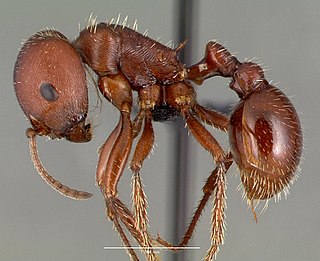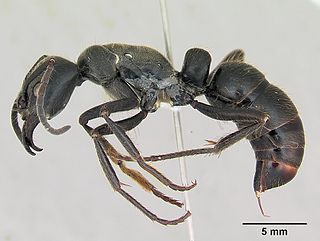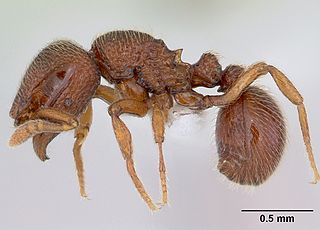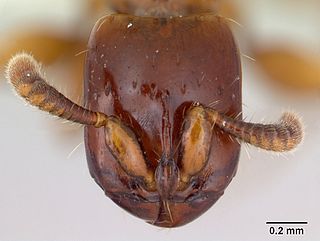
Ponerinae, the ponerine ants, is a subfamily of ants in the Poneromorph subfamilies group, with about 1,600 species in 47 extant genera, including Dinoponera gigantea - one of the world's largest species of ant. Mated workers have replaced the queen as the functional egg-layers in several species of ponerine ants. In such queenless species, the reproductive status of workers can only be determined through ovarian dissections.

Pogonomyrmex is a genus of harvester ants, occurring primarily in the deserts of North, Central, and South America, with a single endemic species from Haiti.

Aenictus is a large army ant genus distributed in the Old World tropics and subtropics. It contains about 181 species, making it one of the larger ant genera of the world.

Cryptopone is a genus of ants in the subfamily Ponerinae. The genus has a worldwide distribution, with most species occurring in Asia. Workers range from very small to medium in size (1.7–6.1 mm), with the queens being slightly larger.

Dinoponera australis is a species of ant notable for its lack of distinct queen caste.

Dinoponera is a strictly South American genus of ant in the subfamily Ponerinae, commonly called tocandiras or giant Amazonian ants. These ants are generally less well known than Paraponera clavata, the bullet ant, yet Dinoponera females may surpass 3–4 cm (1.2–1.6 in) in total body length, making them among the largest ants in the world.

Acanthostichus is a predatory and predominantly subterranean genus of ant in the subfamily Dorylinae. They are found in the New World, from the southern United States to Uruguay, Paraguay and northern Argentina. They are probably common, but due to their subterranean nature, they are seldom collected or seen.

Dicroaspis is an African genus of ants in the subfamily Myrmicinae.

Nylanderia is a large genus of ants in the subfamily Formicinae. The genus has a nearly cosmopolitan distribution with species inhabiting a wide array of habitats in almost all geographic regions. Nylanderia, currently containing over 110 species, is an ecologically important genus, with some species reported as being invasive. The ants are small to medium in size and range in color from pale yellow to black.

Dinoponera quadriceps is a queenless species of ants in the subfamily Ponerinae. The species, known from Brazil, is similar to Dinoponera mutica and uses venom for subduing large live prey and defense. Its venom could be of use to the pharmaceutical industry.

Acanthostichus brevicornis is a species of ant belonging to the genus Acanthostichus. Emery first described the species in 1894, and a synonym was given by Bruch in 1924. Their distribution is in South America, in the countries of Argentina, Brazil, Guyana, Paraguay and Suriname.

Buniapone is a monotypic genus of ants in the subfamily Ponerinae. Buniapone amblyops, the single described species, is found in Southern and Southeast Asia.
Dolichoderus debilis is a species of ant in the genus Dolichoderus. Described by Emery in 1890, the species is found in many countries in two continents, including Bolivia, Brazil, Colombia, Costa Rica, French Guiana, Guatemala, Guyana, Panama, Suriname, Trinidad and Tobago and Venezuela.
Dolichoderus diversus is a species of ant in the genus Dolichoderus. Described by Emery in 1894, the species has a widespread distribution in multiple countries, including Brazil, Colombia, Costa Rica, Ecuador, Guyana, Mexico, Panama, Trinidad and Tobago and Venezuela.
Dolichoderus gagates is a species of ant in the genus Dolichoderus. Described by Emery in 1890, the species is endemic to multiple countries, including Bolivia, Brazil, French Guiana, Guyana, Suriname and Venezuela.

Dolichoderus germaini is a species of ant in the genus Dolichoderus. Described by Emery in 1894, the species is endemic to Brazil, Mexico, Paraguay and Peru.
Dolichoderus ghilianii is a species of ant in the genus Dolichoderus. Described by Emery in 1894, the species is endemic to Brazil, and Peru.
Dolichoderus imitator is a species of ant in the genus Dolichoderus. Described by Emery in 1894, the species is endemic to Bolivia, Brazil and Ecuador.
Dolichoderus septemspinosus is a species of ant in the genus Dolichoderus. Described by Emery in 1894, the species is endemic to South America.













